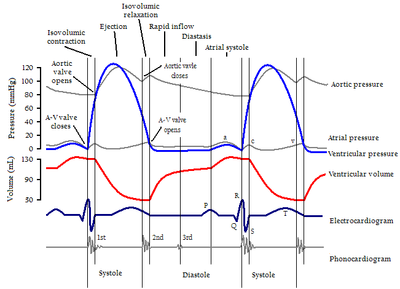
Phonocardiogram
Encyclopedia

Heart
The heart is a myogenic muscular organ found in all animals with a circulatory system , that is responsible for pumping blood throughout the blood vessels by repeated, rhythmic contractions...
with the help of the machine called phonocardiograph, or "Recording of the sounds made by the heart during a cardiac cycle
Cardiac cycle
The cardiac cycle is a term referring to all or any of the events related to the flow or blood pressure that occurs from the beginning of one heartbeat to the beginning of the next. The frequency of the cardiac cycle is described by the heart rate. Each beat of the heart involves five major stages...
." The sounds are thought to result from vibrations created by closure of the heart valve
Heart valve
A heart valve normally allows blood flow in only one direction through the heart. The four valves commonly represented in a mammalian heart determine the pathway of blood flow through the heart...
s. There are at least two: the first when the atrioventricular valves close at the beginning of systole
Systole (medicine)
Systole is the contraction of the heart. Used alone, it usually means the contraction of the left ventricle.In all mammals, the heart has 4 chambers. The left and right ventricles pump together. The atria and ventricles pump in sequence...
and the second when the aortic valve
Aortic valve
The aortic valve is one of the valves of the heart. It is normally tricuspid , although in 1% of the population it is found to be congenitally bicuspid . It lies between the left ventricle and the aorta....
closes at the end of systole. It allows the detection of subaudible sounds and murmurs
Heart murmur
Murmurs are extra heart sounds that are produced as a result of turbulent blood flow that is sufficient to produce audible noise. Most murmurs can only be heard with the assistance of a stethoscope ....
, and makes a permanent record of these events. In contrast, the ordinary stethoscope
Stethoscope
The stethoscope is an acoustic medical device for auscultation, or listening to the internal sounds of an animal body. It is often used to listen to lung and heart sounds. It is also used to listen to intestines and blood flow in arteries and veins...
cannot detect such sounds or murmurs, and provides no record of their occurrence. The ability to quantitate the sounds made by the heart provides information not readily available from more sophisticated tests, and provides vital information about the effects of certain cardiac drugs upon the heart. It is also an effective method for tracking the progress of the patient's disease.

